How to look after a rabbit
Adopting or buying a rabbit as a pet is very common. Below, we give you the necessary advice to know how to look after a rabbit.
pets
Share

Pet rabbits usually awaken a great affinity in animal lovers who increasingly choose them as pets. There are many breeds of rabbits which adapt perfectly to living with people. Belier (French lop-eared) rabbits, with their large ears, are one of the most popular to keep at home, but the dwarf rabbit, rex, hotot, lionhead, angora or the common European rabbit are some of the most common breeds.
But, if you don’t have one yet, a good option is adoption. First of all, you should know whether you will be able to look after the animal for its whole lifetime, as well as checking with the vet or animal behaviourist to properly understand rabbits’ characteristics. The life expectancy of a rabbit depends on the breed and the size, but they usually live for between eight and ten years.
What care a pet rabbit needs
It is important to know that they are sociable animals and, wherever possible, you should have two of them so they can keep each other company. They should also have space and not always be kept in a rabbit hutch, so they can run and have a life which is as similar as possible to life in the wild. The ideal enclosure for one or two rabbits is four square metres and you should add two square metres for each extra rabbit.
The hutch should be comfortable and contain a feeder and drinker, a comfortable bed for sleeping in, a tray with wood shavings for them to use as a toilet and a bathing area.
It is important to take them for an annual check up to the vets and to keep an eye on their behaviour because they are susceptible to catching diseases. For this reason, you need to monitor symptoms such as not wanting to eat, being apathetic, not moving or having mucus, among others. The most common diseases of a rabbit are usually a cold, fungal infection, heat stroke or scabies.
Castration is also important, it can be carried out when the animal is at least 6 months old, to prevent reproduction and possible diseases.
Rabbits are very clean animals and it isn’t necessary to bath them, but it is important to brush them every day to remove dead hair and so hair balls don’t form in their stomachs. When it comes to cutting their nails, you should check with the vet, use a specific nail cutter and be very careful when it comes to cutting, given that you could make them bleed.

Feeding a pet rabbit
The good health of a rabbit has quality food and veterinary care as fundamental pillars. The ideal food for a rabbit is made up of 80% hay or fresh grass, 20% fresh food (leaf vegetables or wild herbs) and supplements, which can be top quality feed and healthy treats, that you can give as rewards. They can also be given fruit as a reward or supplement to food.
Permitted fruits | Permitted vegetables | Vegetables in moderation | Poisonous foods |
Apricot Blueberry Cherry Plum Raspberry Strawberry Kiwi Apple Peach Melon Papaya Pear Pineapple Watermelon | Achard Artichoke Watercress Lamb's Lettuce Dandelion Green beans Red pepper Rocket Clover Carrot | Alfalfa Broccoli Pumpkin Courgette Celery Cabbage Cucumber Tomato | Parsley Potato Onion Leak Garlic Bitter almond Chocolate |
Most common diseases
Vaccinations are fundamental for rabbits, given there are two diseases you should prevent at all costs: myxomatosis and viral haemorrhagic disease. Myxomatosis is transmitted through direct contact via mosquitos or fleas. It is a disease that causes a slow and painful death. Pet rabbits have almost no chance of survival. They should be vaccinated in spring and autumn. For rabbits who are in countryside areas or who go outside in areas where there are wild rabbits relatively nearby, it is recommended to vaccinate them every 3 months.
Viral haemorrhagic disease (VHD) is transmitted by direct or indirect contact via contaminated objects or animals. It is a disease that can kill a rabbit without prior symptoms. They are vaccinated for this once a year, preferably in spring.






